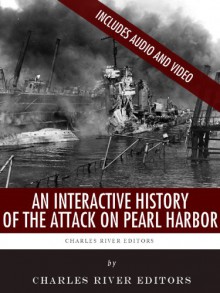Includes:•An original history about the Attack on Peal Harbor•Audio: An original radio broadcast breaking news of the attack•Video: Avenge December 7 , a government advertisement for war bonds• Video: A contemporary newsreel on the attack•American and Japanese documents from Pearl Harbor, and...
show more
Includes:•An original history about the Attack on Peal Harbor•Audio: An original radio broadcast breaking news of the attack•Video: Avenge December 7 , a government advertisement for war bonds• Video: A contemporary newsreel on the attack•American and Japanese documents from Pearl Harbor, and FDR’s speech seeking a declaration of war after Pearl Harbor“We won a great tactical victory at Pearl Harbor and thereby lost the war.” – Admiral Hara TadaichiAll Americans are familiar with the “day that will live in infamy.” At 9:30 a.m. on Sunday, December 7, 1941, Pearl Harbor, the advanced base of the United States Navy’s Pacific Fleet, was ablaze. It had been smashed by aircraft launched by the carriers of the Imperial Japanese Navy. All eight battleships had been sunk or badly damaged, 350 aircraft had been knocked out, and over 2,000 Americans lay dead. Indelible images of the USS Arizona exploding and the USS Oklahoma capsizing and floating upside down have been ingrained in the American conscience ever since. In less than an hour and a half the Japanese had almost wiped out America’s entire naval presence in the Pacific.Less than 24 hours earlier, Japanese and American negotiators had been continuing their diplomatic efforts to stave off conflict in the region, but as they did, President Roosevelt and his inner circle had seen intelligence reports strongly suggesting an imminent attack - though they did not know where. The U.S. rightly believed that Japan would take action to prevent the Americans from interfering with their military activities in Southeast Asia, and American military forces in the Philippines were already bracing for a potential attack. However, as the negotiations were ongoing, the powerful Japanese carrier fleet had been surging southwards through the Pacific while maintaining radio silence, preparing to strike the blow that would ignite war in an area spanning half the globe. Navy Commander-in-Chief Isoroku Yamamoto, whose code of honor demanded that the Japanese only engage enemies after a formal declaration of war, had been given assurances that his nation would be formally at war with the United States prior to the arrival of his planes over Pearl Harbor.As it turned out, those assurances were worth nothing, and Yamamoto had been misled by extremists in his government just as the Americans were misled. In fact, the Japanese would infamously deliver documents formally cutting off negotiations with the American government after the attack on Pearl Harbor had already been conducted. Far from a formal declaration of war, America was attacked without warning, plunging the world’s largest democracy into history’s deadliest conflict.Pearl Harbor was unquestionably one of the seminal events in American history, and given the nature of the surprise attack, the entry of the U.S. into the war, and the lingering controversies and conspiracy theories, the attack on Pearl Harbor continues to be a highly charged and heavily debated event.An Interactive History of The Attack on Pearl Harbor Collection chronicles the history leading up to the surprise attack, the attack itself, its aftermath, its lasting legacy and the controversies still surrounding it. This collection includes an original history about the attack, contemporary news and video reports about the attack, communications between the American and Japanese governments before the attack, and President Roosevelt’s famous speech seeking a declaration of war after the attack. It also includes pictures and a Table of Contents.
show less

